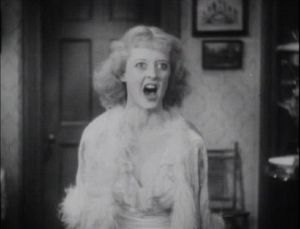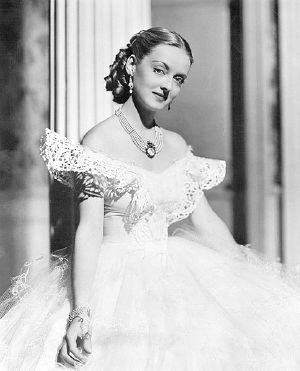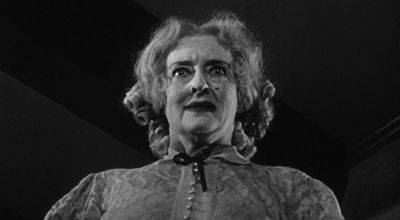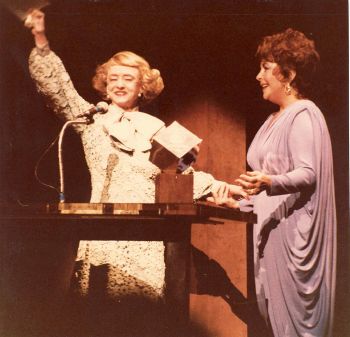Bette Davis
| Bette Davis | |
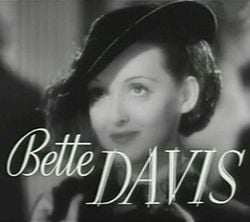 from the Jezebel film trailer, 1938. | |
| Birth name: | Ruth Elizabeth Davis |
|---|---|
| Date of birth: | April 5, 1908 |
| Birth location: | Lowell, Massachusetts |
| Date of death: | October 6, 1989 |
| Death location: | Neuilly, France |
| Height: | 5' 3" (1.60 m) |
| Academy Awards: | Best Actress 1935 Dangerous 1938 Jezebel |
| Spouse: | Harmon Nelson (1932–1938) Arthur Farnsworth (1940–1943) William Grant Sherry (1945–1950) Gary Merrill (1950–1960) |
Bette Davis (April 5, 1908 – October 6, 1989), born Ruth Elizabeth Davis, was a two-time Academy Award-winning American actress of film, television, and theater.
Noted for her willingness to play unsympathetic characters, she was highly regarded for her performances in a range of film genres, from contemporary crime melodramas to historical and period films to the occasional comedy, though her greatest successes were romantic dramas.
Early Acting Career
Ruth Elizabeth Davis, known from early childhood as "Betty," was born in Lowell, Massachusetts, to Harlow Morrell Davis and Ruth ("Ruthie") Augusta Favor. She had one younger sister. The family was of English, French, and Welsh ancestry. In 1915, Davis' parents separated and, in 1921, Ruth Davis moved to New York City with her daughters, where she worked as a photographer. Betty was inspired to become an actress after seeing Rudolph Valentino in The Four Horsemen of the Apocalypse (1921) and Mary Pickford in Little Lord Fauntleroy (1921). She changed the spelling of her name to "Bette" after Honoré de Balzac's La Cousine Bette.
She attended Cushing Academy, a finishing school in Ashburnham, Massachusetts where she met her future husband, Harmon O. Nelson. In 1926, she saw a production of Henrik Ibsen's The Wild Duck with Blanche Yurka and Peg Entwistle. Davis later recalled that it inspired her full commitment to her chosen career, and said, "Before that performance I wanted to be an actress. When it ended, I had to be an actress...exactly like Peg Entwistle." She auditioned for admission to Eva LeGallienne's Manhattan Civic Repertory, but was rejected by LeGallienne who described her attitude as "insincere" and "frivolous." She was accepted by the John Murray Anderson School of Theatre, where she also studied dance with Martha Graham.
She auditioned for George Cukor's stock theater company, and although he was not impressed, he gave Davis her first paid acting assignment and a one week stint playing the part of a chorus girl in the play Broadway. She was later chosen to play Hedwig, the character she had seen Peg Entwistle play in The Wild Duck. After performing in Philadelphia, Washington, D.C., and Boston, she made her Broadway debut in 1929 in Broken Dishes, and followed it with Solid South. She was seen by a Universal Studios talent scout, who invited her to Hollywood for a screen test.
Transition from Stage to Film
Accompanied by her mother, Davis traveled by train to Hollywood, arriving on December 13, 1930. She later recounted her surprise that nobody from the studio was there to meet her; a studio employee had waited for her, but left because he saw nobody who "looked like an actress." She failed her first screen test but was used in several screen tests for other actors. Carl Laemmle, the head of Universal Studios, considered terminating Davis' employment, but the cinematographer Karl Freund told him she had "lovely eyes" and would be suitable for The Bad Sister (1931), in which she subsequently made her film debut. The film was not a success, and her next role in Seed (1931) was too brief to attract attention.
Universal Studios renewed her contract for three months, and she appeared in Waterloo Bridge (1931) before being loaned to Columbia Pictures for The Feathered Serpent and The Menace, and to Capital Films for Hell's House (all 1932). After nine months, and six unsuccessful films, Laemmle elected not to renew her contract.
George Arliss chose Davis for the lead female role in The Man Who Played God (1932), and for the rest of her life, Davis credited him with helping her achieve her "break" in Hollywood. The Saturday Evening Post wrote, "she is not only beautiful, but she bubbles with charm," and compared her to Constance Bennett and Olive Borden. Warner Brothers signed her to a five year contract.
In 1932, she married Harmon Nelson, who was scrutinized by the press; his $100 a week earnings compared unfavorably with Davis' reported $1000 a week income. Davis addressed the issue in an interview, pointing out that many Hollywood wives earned more than their husbands, but the situation proved difficult for Nelson, who refused to allow Davis to purchase a house until he could afford to pay for it himself.[1]
After more than 20 film roles, she had her critical breakthrough playing the role of the vicious and slatternly Mildred Rogers in the RKO Radio production of Of Human Bondage (1934), a film adaptation of W. Somerset Maugham's novel, earned Davis her first major critical acclaim.
The next year, her performance as a down-and-out troubled actress in Dangerous (1935) received very good reviews and landed Davis her first Best Actress nomination, and she won the Academy Award. Commenting on her performance, E. Arnot Robertson wrote in Picture Post:
I think Bette Davis would probably have been burned as a witch if she had lived two or three hundred years ago. She gives the curious feeling of being charged with power which can find no ordinary outlet.[2]
Success as "The Fourth Warner Brother"
Davis began work on Marked Woman (1937), a contemporary gangster drama inspired by the case of Lucky Luciano. The film, and Davis' performance, received excellent reviews and her stature as a leading actress was enhanced.
David O. Selznick was conducting a search for an actress to play Scarlett O'Hara, a role Davis coveted, in Gone with the Wind, and a radio poll named Davis as the audience favorite. Warner offered her services to Selznick as part of a deal that also included Errol Flynn, but Selznick did not consider Flynn as suitable for the part of Rhett Butler, and rejected the offer.
Davis won a second Academy Award for her next film, Jezebel (1938), in which she portrayed a willful and self absorbed Southern belle, much like Scarlett. Jezebel marked the beginning of the most successful phase of Davis' career. She was listed in the annual "Quigley Poll of the Top Ten Money Making Stars," which was compiled from the votes of movie exhibitors throughout the United States. In contrast to Davis' success, her husband, Harmon Nelson, had failed to establish a career for himself, and their relationship faltered and eventually they divorced.
Davis appeared in three other box office hits in 1939, The Old Maid, Juarez, and The Private Lives of Elizabeth and Essex. The latter was her first color film, and was one of her few color films made during the height of her career. To play the elderly Elizabeth I of England, Davis shaved her hairline and eyebrows. During filming she was visited on the set by the actor, Charles Laughton. She commented that she had a "nerve" playing a woman in her sixties, to which Laughton replied, "Never not dare to hang yourself. That's the only way you grow in your profession. You must continually attempt things that you think are beyond you, or you get into a complete rut." Recalling the episode many years later, Davis remarked that Laughton's advice had influenced her throughout her career.[3]
By this time, Davis was Warner Brothers' most profitable star, described as "The Fourth Warner Brother," and she was given the most important of their female leading roles.[4] Her image was considered with more care; although she continued to play character roles, she was often filmed in close-ups that emphasized her distinctive eyes. In 1940 Davis met Arthur Farnsworth, a New England innkeeper. They were married in December of that year.
War Effort and the Hollywood Canteen
Following the Japanese attack on Pearl Harbor, Davis spent the early months of 1942 traveling across the country selling war bonds.[4] She sold two million dollars worth of bonds in two days, as well as a picture of herself in Jezebel for $250,000. She also performed for black regiments as the only white member of an acting troupe formed by Hattie McDaniel, that also included Lena Horne and Ethel Waters.
When John Garfield discussed opening a serviceman's club in Hollywood, Davis responded enthusiastically. With the aid of Warner, Cary Grant, and Jule Styne, they transformed an old nightclub into the "Hollywood Canteen," which opened on October 3, 1942. Hollywood's most important stars volunteered their time and talents to entertain servicemen prior to them being sent to war. Davis ensured that every night there would be at least a few important "names" for the visiting soldiers to meet, often calling on friends at the last moment to ensure the soldiers would not be disappointed. The canteen remained in operation until the end of World War II. Davis later commented, "There are few accomplishments in my life that I am sincerely proud of. The Hollywood Canteen is one of them."[5] In 1980, she was awarded the Distinguished Civilian Service Medal, the United States Department of Defense's highest civilian award, for her work with the Hollywood Canteen.
Personal and Professional Setbacks
In August 1943, Davis' husband, Arthur Farnsworth, collapsed while walking along a Hollywood street, and died two days later. An autopsy revealed that his fall had been caused by a skull fracture which had occurred about two weeks earlier. Davis testified before an inquest that she knew of no event that might have caused the injury, and a finding of "accidental death" was reached. Highly distraught, she attempted to withdraw from her next film, but Jack Warner, who had halted production following Farnsworth's death, convinced her to continue.
She married an artist, William Grant Sherry, in 1945. She had been drawn to him partly because he had never heard of her and was therefore not intimidated by her, but after their marriage the disparity between their levels of professional success and earnings led to tensions and arguments.
In 1947, Davis gave birth to a daughter, Barbara (known as B.D.) and later wrote in her memoir that she became absorbed in motherhood and considered ending her career. Her relationship with Sherry began to deteriorate and she continued making films, but her popularity with audiences was steadily declining. After the completion of Beyond the Forest (1949), Jack Warner released Davis from her contract, at her request. The reviews that followed were scathing; Newsweek called it "undoubtedly one of the most unfortunate stories [Davis] has ever tackled," while Dorothy Manners writing for the Los Angeles Examiner criticized the "sheer hysteria and overexposed histrionics" of Davis' performance, and described the film as "an unfortunate finale to her brilliant career."[6] Hedda Hopper wrote, "If Bette had deliberately set out to wreck her career, she could not have picked a more appropriate vehicle."[1]
In July 3, 1950 Davis became divorced from William Sherry, and on July 28 she married Gary Merrill. With Sherry's consent, Merrill adopted B.D., Davis' daughter with Sherry, and in 1950, Davis and Merrill adopted a baby girl they named Margot and a baby boy, Michael, in 1952. The family traveled to England, where Davis and Merrill starred in a murder-mystery film, Another Man's Poison. When it received lukewarm reviews and failed at the box office, Hollywood columnists wrote that Davis' comeback had petered out.
Later Career
In 1962, Davis opened in the Broadway production, The Night of the Iguana to mostly mediocre reviews, and left the production after four months due to "chronic illness." She then joined Glenn Ford and Ann-Margret for the Frank Capra film A Pocketful of Miracles.
She accepted her next role, in the Grand Guignol horror film, What Ever Happened to Baby Jane? after reading the script and believing it could appeal to the same audience that had recently made Alfred Hitchcock's Psycho (1960) a success. She negotiated a deal that would pay her ten percent of the worldwide gross profits, in addition to her salary. Davis received her last Oscar nomination was for the film, which became one of the year's biggest successes. It also starred her famous rival Joan Crawford. Davis and Crawford played two aging sisters, former actresses forced by circumstance to share a decaying Hollywood mansion. The director, Robert Aldrich, explained that Davis and Crawford were each aware of how important the film was to their respective careers, and commented: "It's proper to say that they really detested each other, but they behaved absolutely perfectly."[7]
Davis sustained her comeback over the course of several years. Hush... Hush, Sweet Charlotte (1964) was Aldrich's follow-up to What Ever Happened to Baby Jane? The film was a considerable success and brought renewed attention to its veteran cast.
In the early 1970s, Davis was invited to appear in New York in a stage presentation, Great Ladies of the American Cinema. Over five successive nights, a different female star discussed her career and answered questions from the audience; Myrna Loy, Rosalind Russell, Lana Turner, and Joan Crawford were the other participants. Davis was well received and was invited to tour Australia with the similarly themed Bette Davis in Person and on Film, and its success allowed her to take the production to the England.
In 1977, Davis became the first woman to receive the American Film Institute's Lifetime Achievement Award. The televised event included comments from several of Davis' colleagues including William Wyler, Jane Fonda, Henry Fonda and Olivia de Havilland.
Following the telecast she found herself in demand again, often having to choose between several offers. Her name became well known to a younger audience, when songstress Kim Carnes's Bette Davis Eyes became a worldwide hit and the highest selling record of 1981 in the United States, where it stayed at number one on the music charts for more than two months. Davis' grandson was impressed that she was the subject of a hit-song and Davis considered it a compliment. She wrote to both Carnes and the songwriters, and accepted the gift of gold and platinum records from Carnes, and hung them on her wall.
She continued acting mostly for television, appearing in Family Reunion (1981) opposite her grandson J. Ashley Hyman, A Piano for Mrs. Cimino (1982), and with James Stewart in Right of Way (1983).
Illness and Death
In 1983, she was acting in the television series Hotel when she was diagnosed with breast cancer and underwent a mastectomy. Within two weeks of her surgery she suffered four strokes which caused paralysis in the right side of her face and in her left arm, and left her with slurred speech. She commenced a lengthy period of physical therapy and, aided by her personal assistant, Kathryn Sermak, gained partial recovery from the paralysis.
During 1988 and 1989, Davis was feted for her career achievements, receiving the Kennedy Center Honor, the Legion of Honor from France, the Campione d'Italia from Italy and the Film Society of Lincoln Center Lifetime Achievement Award. She collapsed during the American Cinema Awards in 1989 and later discovered that her cancer had returned. She recovered sufficiently to travel to Spain where she was honored at the Donostia-San Sebastián International Film Festival, but during her visit her health rapidly deteriorated. Too weak to make the long journey back to the United States, she traveled to France where she died on October 6, 1989, at the American Hospital in Neuilly-sur-Seine.
She was interred in Forest Lawn-Hollywood Hills Cemetery in Los Angeles, California, alongside her mother, Ruthie, and sister, Bobby. On her tombstone is written: "She did it the hard way," an epitaph that had been suggested to her by Joseph L. Mankiewicz shortly after they had filmed All About Eve.
Legacy
In addition to her two Academy Awards for Best Actress, Davis established several Oscar milestones. Among them, she became the first person to earn five consecutive Academy Award nominations for acting, all in the Best Actress category (1938–1942). In 1962, she became the first person to secure 10 Academy Award nominations for acting.
Her film choices were often unconventional: Davis sought roles as manipulators and killers in an era when actresses usually preferred to play sympathetic characters, and she excelled in them. She favored authenticity over glamour, and was willing to change her own appearance if it suited the character.[8]
Her death made front-page news throughout the world as the "close of yet another chapter of the Golden Age of Hollywood." Angela Lansbury summarized the feeling of those of the Hollywood community who attended her memorial service, commenting, after a sample from Davis's films was screened, that they had witnessed "an extraordinary legacy of acting in the twentieth century by a real master of the craft" that should provide "encouragement and illustration to future generations of aspiring actors."[1]
In 1997, the executors of her estate, Michael Merrill, her son, and Kathryn Sermak, her former assistant, established "The Bette Davis Foundation" which awards college scholarships to promising actors and actresses.
Notes
- ↑ 1.0 1.1 1.2 James Spada, More Than a Woman: An Intimate Biography of Bette Davis (Little Brown & Co, 1993, ISBN 0316908800).
- ↑ Peter Noble, Bette Davis: A Biography (London: Skelton Robinson, 1948).
- ↑ Charlotte Chandler, The Girl Who Walked Home Alone: Bette Davis, a Personal Biography (New York: Simon & Schuster, 2006, ISBN 9780743262088).
- ↑ 4.0 4.1 Martin Shingler, The Fourth Warner Brother and Her Role in the War] Journal of American Studies 30(1) (April, 1996): 127-131. Retrieved July 12, 2022.
- ↑ Bette Davis and the Hollywood Canteen Old Hollywood Films, March 24, 2017. Retrieved July 12, 2022.
- ↑ Gene Ringgold and Lawrence J. Quirk, The Complete Films of Bette Davis (Citadel Press, 1990, ISBN 978-0806511771).
- ↑ Fred Lawrence Guiles, Joan Crawford, The Last Word (Chrysalis Books, 1995, ISBN 978-1857932683).
- ↑ David Shipman, Movie Talk: Who Said What about Whom in the Movies (St. Martin's Press, 1989, ISBN 978-0312034030).
ReferencesISBN links support NWE through referral fees
- Chandler, Charlotte. The Girl Who Walked Home Alone: Bette Davis, a Personal Biography. New York: Simon & Schuster, 2006. ISBN 9780743262088
- Guiles, Fred Lawrence. Joan Crawford, The Last Word. Chrysalis Books, 1995. ISBN 978-1857932683
- Hadleigh, Boze. Bette Davis Speaks. New York: Barricade Books, 1996. ISBN 1569800669
- Higham, Charles. Bette: The Life of Bette Davis. New York: Macmillan, 1981. ISBN 0025515004
- Leaming, Barbara. Bette Davis: A Biography. New York: Simon & Schuster, 1992. ISBN 0671709550
- Noble, Peter. Bette Davis: A Biography. London: Skelton Robinson, 1948. ASIN B0020RINZ0
- Ringgold, Gene, and Lawrence J. Quirk. The Complete Films of Bette Davis. Citadel Press, 1990. ISBN 978-0806511771
- Shipman, David. Movie Talk: Who Said What about Whom in the Movies. St. Martin's Press, 1989. ISBN 978-0312034030
- Spada, James. More Than a Woman: An Intimate Biography of Bette Davis Little Brown & Co, 1993. ISBN 0316908800
- Vermilye, Jerry. Bette Davis. New York: Galahad Books, 1974. ISBN 088365167X
External Links
All links retrieved September 29, 2023.
- Bette Davis IMDb
- Bette Davis Find a Grave
- Bette Davis Turner Classic Movies
Credits
New World Encyclopedia writers and editors rewrote and completed the Wikipedia article in accordance with New World Encyclopedia standards. This article abides by terms of the Creative Commons CC-by-sa 3.0 License (CC-by-sa), which may be used and disseminated with proper attribution. Credit is due under the terms of this license that can reference both the New World Encyclopedia contributors and the selfless volunteer contributors of the Wikimedia Foundation. To cite this article click here for a list of acceptable citing formats.The history of earlier contributions by wikipedians is accessible to researchers here:
The history of this article since it was imported to New World Encyclopedia:
Note: Some restrictions may apply to use of individual images which are separately licensed.
